|
|
ITE - Innovative
Television Equipment

|
| FROM AN ADVERTISEMENT HANDED OUT BY ITE THAT
WAS REPRINTED WITH PERMISSION FROM: "ON LOCATION MAGAZINE" THE
FILM & VIDEOTAPE PRODUCTION MAGAZINE
Equipment
Innovative Television Equipment
Taking A bITE Out Of The
Camera Accessories Market
By IAIN BLAIR

Bert Rosenberg, President of ITE and chief design engineer.
The three-letter logo, ITE, on the side of the company's world
headquarters in Woodland Hills, Calif., may not have the familiar ring of
IBM or RCA, but in its own way it spells out a success story that is no
less impressive than those of such globally influential super-companies.
For ITE stands for Innovative Television Equipment, one of the country's
leading operations in both the design and manufacture of camera support
equipment. And even if you don't recognize the name, the chances are
you're using one of their camera heads, tripods, dollies, pedestals, carts
or other accessories in a wide array of applications ranging from
broadcast and industrial to educational and closed-circuit television.
The company was formed in the late '60s by president Bert Rosenberg and
vice president/treasurer Stanton Hollingsworth, who originally met while
working for Houston Fearless, a well-known support equipment manufacturer
at that time. "I was there for some 12 years before teaming up with
Stanton and leaving to form ITE in May 1969," explains Rosenberg, who
graduated in engineering from UCLA in the '50s. "It just seemed like
a natural move for both of us, especially as the marketplace was wide open
at the time and there were an enormous amount of changes taking place in
the business. You've got to remember that even back then, there were vast
reductions in the weight of cameras along with all the new, emerging color
technology and lower cost equipment, and it opened the doors for
innovations and changes in the support business as well."
"Bert had seen the weight of a television camera drop
dramatically, from over 300 pounds down to 150 pounds, while we were still
at Houston Fearless," comments Hollingsworth, "and realized at
the same time there simply weren't any new pieces of camera support
equipment out on the market to deal with such developments. So we sat down
and came up with a plan and a clear-cut objective to create a whole new
line of support equipment to service the emerging lines of low-weight,
lower-cost color television cameras."
"The broadcast support business is a very small, tight fraternity,
and no one seemed to have a handle on these or any other future
developments," continues Rosenberg. "So when we went ahead and
formed ITE, we got a lot of initial encouragement and enthusiasm from all
the big boys at the major camera manufacturers. It's always been a good
balance, as my background as a mechanical designer and engineer is
complemented and balanced by Stanton's training as a financial expert and
CPA - those were the basis of the company, making sure we covered both
ends of the business."
A few products to start
Having struck out on their own, Rosenberg and Hollingsworth decided to
test the waters by initially designing and manufacturing just three or
four products. "I sat down and designed a studio pedestal, a pan and
tilt head, a tripod and a dolly
that was our complete line. We also started by getting all of these
manufactured by an outside company," he adds. By contrast, today, ITE
manufactures over 50% of its product line on its own premises, and that
line has expanded to over 85 products - "so many, we just stopped
counting," laughs Rosenberg.
Despite such impressive statistics, it wasn't always an easy road for
the two partners, as they willingly admit. "All that initial
enthusiasm and encouragement from the major camera manufacturers
evaporated pretty quickly," says Hollingsworth. "After about
half an hour!" recalls Rosenberg. "Of course everyone is very
wary of dealing with a brand new company, even if they know your past
record is good," he continues. "And if someone's going to spend
half a million bucks on cameras, they're not going to take many chances on
the heads turning out to be duds. Consequently, the first few years were
extremely rough for us. It was very slow, and things weren't helped much
when we were also hit by a very bad recession in the early to mid-'70s.
"In fact, I remember a time when we were sitting on some 75
pedestals stacked out at a warehouse at LAX that were just collecting dust
and taking up an awful lot of space," recalls Rosenberg.
"Business was so slow that we seriously considered selling them off
cheap as seaanchors! Fortunately, things turned around in the nick of
time, and our tenacity and stubbornness not to give in suddenly paid off.
And since then, we haven't looked back. But we've never forgotten those
days of struggle either, and I think that's always helped us concentrate
on the value of good service and the highest possible quality of
product."
Much of ITE's success is due to sound, long-term financial planning, as
Hollingsworth explains. "When we started, we knew that the expense of
manufacturing our own prototypes would be prohibitive, and that would
severely limit our ability to experiment with a design. So we immediately
began looking around for the most cost-effective methods of manufacturing,
and after extensive research, we decided on opening up an Australian
company for the simple reason that at that time, one tooling hour was
costing just under $4, while in the U.S. the same work was costing closer
to $40 - ten times as much as in Australia. So it was primarily an
economically motivated move, which then allowed us the luxury of being
able to tryout various prototype designs at a relatively low cost.
"We basically go through three prototype stages," reports
Hollingsworth. "We start with the engineering prototype, in which
Bert designs a new product to specifically accommodate a new piece of
camera equipment. We'll then produce five or 10 of these prototypes and
then choose between six and 10 dealers to test them, and see what comments
and suggestions they have to make.
"The second stage is the redesign process," he continues.
"We incorporate all of these ideas and changes, and then do a sizable
run of the product. For instance, if it's a studio pedestal, we might make
10 to 15. If it's a tripod, the figures would be closer to 25 to 50. We
then distribute those to the field as finished products, but we also track
them all very carefully. We make a point of following up by both mail and
phone calls to get more comments and suggestions - anything to add to a
final evaluation of the product."
ITE markets nearly 20 different types of heads,
ranging from their top-of-the-line ITE-100 Hydrocam model, which
includes dual handles and wedge adapter, down to their ITE-H30 fluid
head model. All models are equipped with either single or dual-control
handles, and the single-handle models may also be ordered with a second,
optional handle. All their fluid and hydro models include an integral
spirit level, and like the tripods, are all finished in black wrinkle to
reduce light bounce to an absolute minimum.
"This process then leads to the final design, which is basically
then chiseled in granite," adds Rosenberg. "By this point, it
has to be absolutely right in every possible respect, because this final
design will have a life of between 10 and 15 years. And at this stage of
the product, we also commit to more expensive tooling and permanent
casting, etc. And, of course, we now also update and retrofit that first
production run - which, in reality, was a prototype run.
"This three-part method hasn't changed at all over the 16 years of
ITE's history, so it definitely works," Rosenberg continues.
"But on the other hand, the time taken to get through all three
stages has increased dramatically. We used to be able to design a
completely new product, do all the testing, and get it out there in a
relatively short time period, perhaps within one year in most cases. But
today, it usually takes a good two years to complete the same steps - for
a number of reasons. For a start, there's the increasing sophistication of
the products themselves, and the increase in sophistication of designs
requires increased sophistication in the tooling and manufacturing
processes. On top of that, there's been an enormous increase in the number
of dealers now working in the marketplace out there."
Widespread dealer network
"When we started in the late '60s, we only really dealt with three
big companies: RCA, General Electric and Visual Electronics, and they
represented over 90% of our total business," points out Rosenberg.
"But today, it's a very different scenario. You now have 11 camera
manufacturers and they represent a mere 20% of our sales. The reason for
this huge change is that those camera manufacturers now sell primarily
through dealers. Now, I do spend time talking with Ikegami, Hitachi,
Philips, Sharp, Sony and others, but the reality of the business today is
that it's all done through the dealers."
Because of this swing, ITE now spends a lot of time talking with the
camera manufacturers for their basic input on design issues, says
Rosenberg. "Their input is extremely important for both our
endproduct and our relationship with the dealers. We now have a widespread
dealer network consisting of almost 200, right across the country. It
averages out to about four per state, although obviously that number is a
lot higher in the large urban areas such as Southern California,
New York, Texas and Florida. In fact, our best area is the Southeast,
stretching from Texas to Florida and up the East Coast, and we think
that's partly due to the fact that a lot of production facilities either
moved there or set up operations in those areas in recent years."
As proof of their enormous success in all areas throughout the country,
Rosenberg and Hollingsworth have some pretty impressive sales figures at
their fingertips. Over the past 16 years, ITE has sold over 30,000
tripods; 19,000 dollies; 6,000 studio pedestals; and a staggering 35,000
pan-and-tilt heads - fluid, cam and torsion. Their current list of
professional broadcast and audio/video closed-circuit television products
includes a wide range of tripods, from the camera-load capacity of 10
pounds for the ITE- T30 model to the 250-pound capacity of the ITE-MT1
model; they all combine lightweight and ruggedness of design, and are
offered in a wide number of ball leveling, elevation and non-elevation
models.
ITE markets nearly 20 different types of heads, ranging from their
top-of-the-line ITE-100 Hydrocam model, which includes dual handles and
wedge adapter, down to their ITE-H30 fluid head model. All models are
equipped with either single- or dual-control handles, and the single handle
models may also be ordered with a second, optional handle. All their fluid
and hydro models include an integral spirit level, and like the tripods,
are all finished in black wrinkle to reduce light bounce to an absolute
minimum.
The company offers seven studio pedestals, including its new ITE-P2
pneumatic model. "It's essentially the same as our very
successfulITE-P1 model," explains Rosenberg, "except that in
response to today's increasing use of low and ground-level camera angles,
we've further reduced the minimum height from 29
inches down to 26 inches. At the same time, we also increased the diameter
of the steering wheel from 26 inches up to 30 inches for easier handling
and maneuverability. So you can see we're constantly updating and
improving models to cope with a marketplace that's constantly changing.
We're not involved in the consumer market at all, we're purely in the
business of professional broadcast, industrial and closed-circuit
television applications, and our clients are always looking for some new
capability as the basic camera technology moves into new areas."
A cut-throat market
Rapidly changing camera technology over the past few years has helped
turn the camera support equipment business into a highly competitive and
cut-throat market, Rosenberg goes on to point out in some detail.
"You only have to look at the figures since the early '80s - some
five years ago, ENG and EFP camera systems were selling for as much as
$30,000, and the average cost of a tripod and head was around the $2,500
mark. But since then, the market has changed dramatically, and prices have
dropped incredibly. Camera systems are now selling for around $8,000, and
not only are they so much cheaper, but they also offer even higher-quality
pictures, etc.
"Now, I don't think camera prices will drop much lower - there's a
cutoff point where it changes from being a bargain to a suspect piece of
equipment," continues Rosenberg. "But at the same time, those
price drops have had a tremendous effect on our products, which after all
are inextricably bound up with camera systems. Today, that same tripod and
head pack age sells for just $700 - simply because no one's prepared to
pay more, although they expect and demand the same quality, etc. And we
try to give them the same quality."

Rick Low, ITE's Manufacturing Manager (left) checks the output of one of
the numeric-tape controlled automated tooling machines.
"So this means that there's a great need to keep adjusting to
these changing market conditions," comments Hollingsworth,
"because if you don't, you're out of the market. We constantly have
to balance these economic factors with quality control factors, and it's
not easy. However, despite all these potential problems, our overall
volume of sales has been steadily increasing over the years," he
continues. "This is due to a number of factors. For a start, ITE has
much better market penetration today, and our products are pretty well
known everywhere; people know the sort of quality and service they'll get
with our products.
"Secondly, it's basic psychology that as prices drop dramatically
on a piece of equipment, the user tends to treat that equipment with less
care and attention to maintenance," he points out. "If you have
a $30,000 camera, you're going to look after it a lot better than an
$8,000 system, and that's why there's a much faster turnover in camera
equipment today. The same thing also holds true for camera support
equipment. For instance, there's not really a lot that can go wrong with
one of our tripods or heads - they're designed and built to last a long,
long time. The factors that do contribute to obsolescence are a mixture of
sheer physical wear-and-tear in the field, and above all, the changing
requirements of camera systems themselves. Weight factors have changed
incredibly over the years, as have basic design factors - and that means
the balance of the camera, or the vertical center of gravity -
consequently affecting critical design considerations for camera support
equipment.
"Finally, overall falling prices now mean that many companies can
afford to buy
two sets of tripods and heads, and use one set as a backup," adds
Hollingsworth. "It also means that many smaller companies who
previously simply couldn't afford in-house television capabilities are now
able to do so. Obviously, our primary market and sales are still in the
professional broadcast marketplace of both network-owned-and-operated
stations and the independents. We pretty much cover the whole field of
those 1,100 operations, and in some areas such as the Southern states,
we're particularly big."
Wide range of clients
"We also cover the whole spectrum of industrial clients, ranging
from the giants like IBM, Sears Roebuck, Mobil Oil, Chase Manhattan and
General Motors to hospitals and medical facilities, religious
broadcasters, etc.," reports Hollingsworth. "And last but not
least, we also cover the entire cable television marketplace, including
pay-TV, as well as a host of universities and colleges. Educational
training is also very big, and religious programming stations are a
particularly impressive growth industry today - they all have their own TV
studios, which are fully equipped with the latest technology." With
its aggressive marketing strategies and successfully expanding
marketplaces and clientele, ITE today operates plants in both Southern
California and Brisbane, Australia, with a third recent addition located
outside Tokyo, Japan. "We employ 23 staff at our 16,000 square-foot
facility here, and another 17 staff at our Brisbane 17,000 square-foot
facility," reports Rosenberg. "Meanwhile, our operation in Japan
currently produces some six products for us which they manufacture with
our design input, etc.
"We're pretty excited about the future," sums up Rosenberg.
"ITE is expanding in all areas, including the European and Asian
marketplaces. We've established
ourselves through sheer dependability and longevity- and we feel that
our products are of high quality and competitively priced (even though
competing in a foreign market). And we always deliver as required.
"On top of that, we're also planning to diversify into other areas
in the near future," he adds, "and not necessarily in the camera
support business, although it will be allied with it. We'll have something
of an electronics nature to unveil at next year's NAB show. But beyond
that, we're keeping it all under wraps right now."
Whatever surprises ITE has in store, it seems certain that this small
but tough company, which has already successfully carved itself a very
healthy slice of the camera support equipment pie, is looking at a bright
future indeed.

ITE Is headquartered In a modern 16,000 square foot facility In
Woodland Hills, CA.

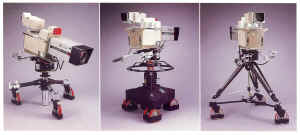 HUGE PHOTO OF THE ONE ABOVE - CLICK TO SEE LARGE!
HUGE PHOTO OF THE ONE ABOVE - CLICK TO SEE LARGE!
ON LOCATION The Film and Videotape Production Magazine, October 1985
|
| |
|

INNOVATIVE TELEVISION
EQUIPMENT 6445 De Soto Avenue
P. O. Box 681 . Woodland Hills, CA 91365 . (213) 888-9421
P1 PNEUMATIC STUDIO
PEDESTAL

The ITE-P1 Studio Pedestal is the first and only
camera support system to be designed to meet ASME pressure vessel safety
codes, It incorporates computer-assisted design parameters and offers a
virtually leakproof pneumatic
counterbalance system for totally safe operation.
The counterbalance system utilizes fingertip control and handles camera
loads up to 290 pounds through an elevation range of from 29% to 51
inches. Vertical and horizontal movement is controlled by the
26-inch-diameter steering wheel.
Both crab and tricycle steering is provided. Rolling
resistance is held to a minimum by use of dual gimbaled
eight-inch-diameter wheels at each corner. Each wheel assembly has its own
adjustable cable guard,
The P1 counterbalanced Studio Pedestal is
constructed with a cast aluminum base for light weight and structural
integrity. The state-of -theart steering and bearing system provides trouble free
operation and ultra-quiet performance,
The P 1 Pedestal interfaces with all ITE pan/tilt
heads,
ITE is a leader in the design and manufacture of
camera heads, dollies, pedestals and accessories for broadcast,
industrial, educational and closed circuit television applications, Our
products are in use by stations throughout the world,
The ITE product line has been designed with your
camera in mind. ITE products provide professional camera support and
control for virtually every video camera package manufactured, The ITE
line is marketed worldwide by all camera manufacturers and by leading
dealers and distributors.
SPECIFICATIONS
Camera Load Capacity - 290 Ibs, (130.50 kg,)
Minimum Height - 29,5" (73.75 em.)
Maximum Height - 51" (127.50 em.)
Air Pressure - Pressure relief valve opens
at 200 PSI representing the
equivalent overload condition of 300 lbs, (750 kg,)
Minimum Doorway
Clearance - 30" (75 em.)
Wheelbase - 28.5" (71.25 em,)
Wheels - Dual, 8" (20 cm,) diameter
cast aluminum
with polyurethane tires
Cable Guard Adjustable from 1/8" (0.31 em,)
to 1" (2.5 em.) above floor
Construction - Cast
aluminum structure with steel tank and outer column to
ASME Pressure Vessel Safety Code; aluminum center column; vinyl coated,
26"
(65 em.) diameter steering wheel
Finish - Black wrinkle hard coat
Prices and specifications subject to change
without notice, © 1983
Total Television Camera Support
Equipment-From The Ground Up
Printed in U,S,A,
|
|
|
  
Interesting H-6 on a T-10 ITE Tripod with a small dolly with the
red wheels... Had not seen a small ITE dolly with the red
wheels usually just the larger ones!
|
|
ABOUT THE ITE TRIPOD, HEAD & DOLLY REFERENCE
SECTION AT SMECC
We have merged the contents for scanning purposes of " The Don
Norwood ITE Collection" and "The AVR of Phoenix ITE
Collection" Here at SMECC. The material will al retain its source
of accusation but will be presented in a combined form.
This consists of catalog sheets, catalogs, maint material and data that
has been unseen out there for ages.
Even our previous offering of the skimpy, but yet the only online
reference material was getting quite a bit of traffic.
I remember when I first started trying to get info on ITE stuff when I
was putting that Phillips LDK-20 up so I could use it and roll it around
.... I had a ITE tripod and there was no weight specs etc out there for
what it would handle. How irritating not to be able to find data!
Don was helpful with a copy of a chart that was in some of his
literature so I put it up online and other people started referring to
it also Then thanks to Don Norwood and AVR of Phoenix we acquired a
large collection of catalog sheets and maint. info and have some
articles on company history for ITE and other Tripods and Pedestals.....
If anyone else has an resource material in paper or electronic image
form please let us know ASAP and we will collate it in with the other
material we are currently scanning and placing on the web site.
We have some nice sections on MILLER and SATCHLER and O'CONNOR and
VINTEN coming up to out of the treasures that people have given us. The
other brands will follow after completion of some of the ITE material.
REMEMBER - Looking for any Illust. Parts breakdowns, maint. manuals,
sales lit. oral history form people that worked at the companies etc....
ANYTHING!
Many Thanks Ed Sharpe - Archivist for SMECC 623-435-1522
Please ship paper goods with insurance and tracking to:
COURYHOUSE/SMECC
ATTN: ED SHARPE - ARCHIVIST
5802 W. PALMAIRE AVE
GLENDALE AZ 85301



ITE H-9 Hydro Head Data and Maintenance


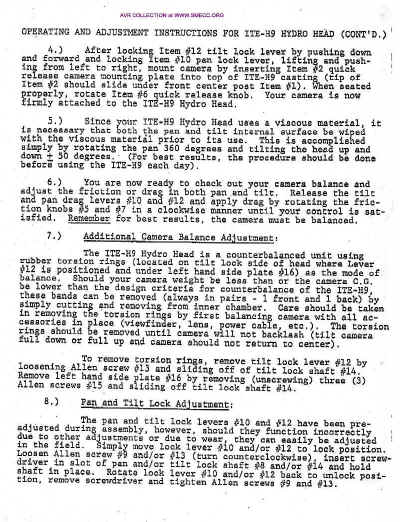

OPERATING AND ADJUSTMENT INSTRUCTIONS FOR ITE-H9 HYPRO HEAD
- BASIC INFORMATION :
Your Model ITE-H9 Hydro Head is a viscous dampened pan/tilt
camera mounting head which is counterbalanced for the elimination
of nose and tail diving and damaging your camera systems. The viscous or fluid dampening action is adjustable (called friction
adjustment) providing totally free to very heavy or tight control in order to suit your preference. Remember;· Viscous or fluid
dampening is a concept designed to make your lightweight compact camera. feel heavy and more controllable without a
jerky motion.
|
|
|
|
|
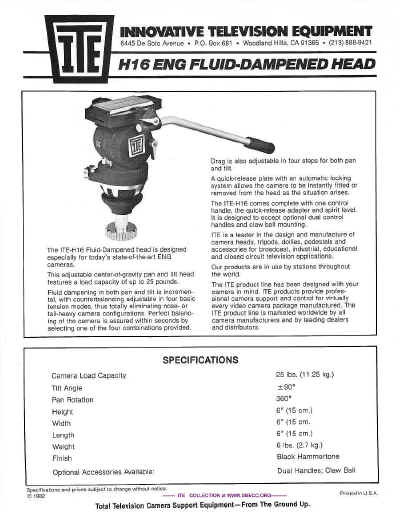 |
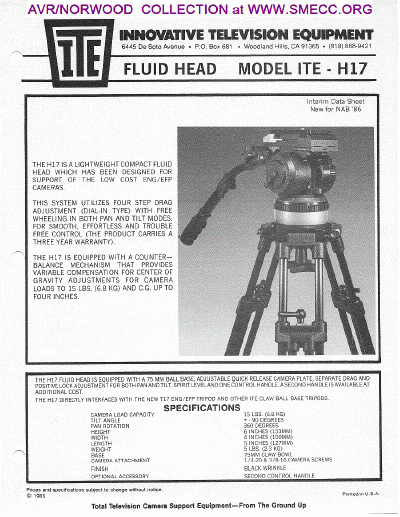 |
|
|
|
|
|
|
|
|
|
|
|
|
|
|
|
ITE H-30 and T-30 Head and Tripod Data and Maintenance

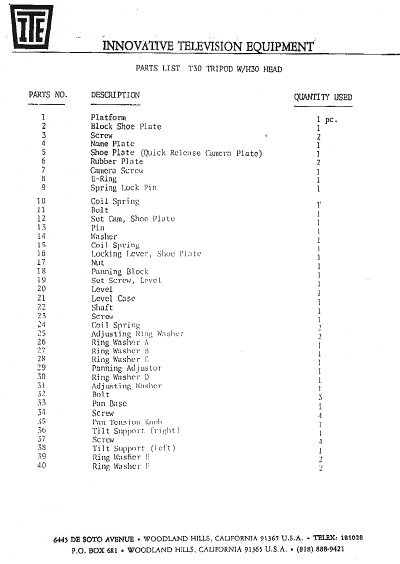
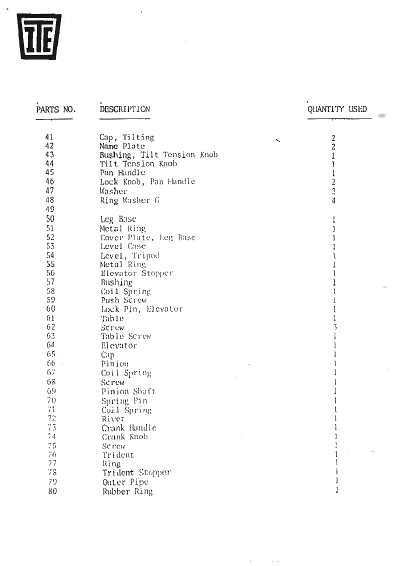
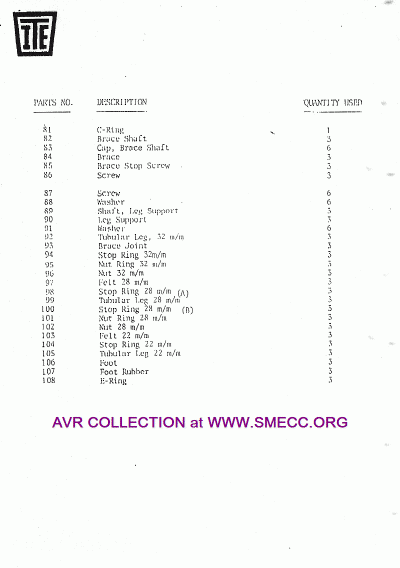
|
|
|
|
ITE H-40 Head Data and Maintenance
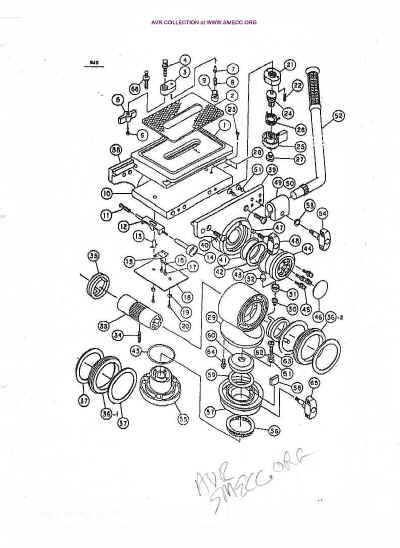
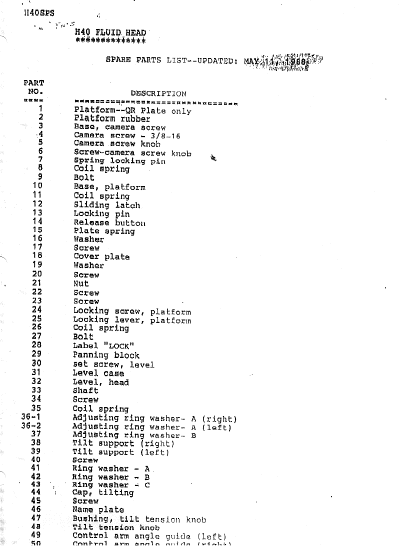

ITE T-40 Tripod Data and Maintenance
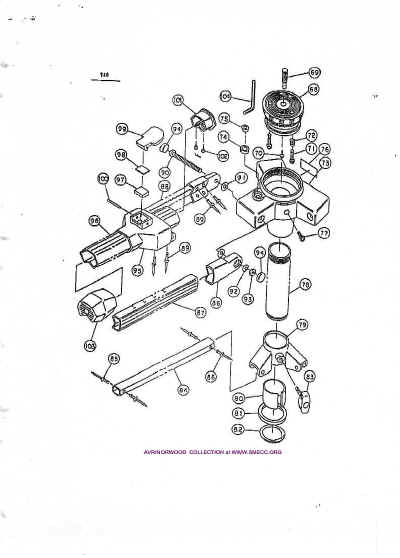
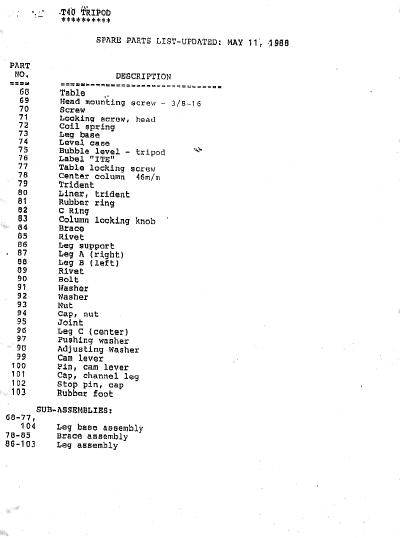 |
|
|
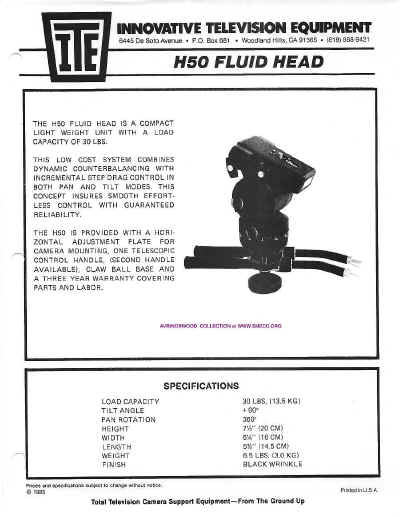 |
|
|
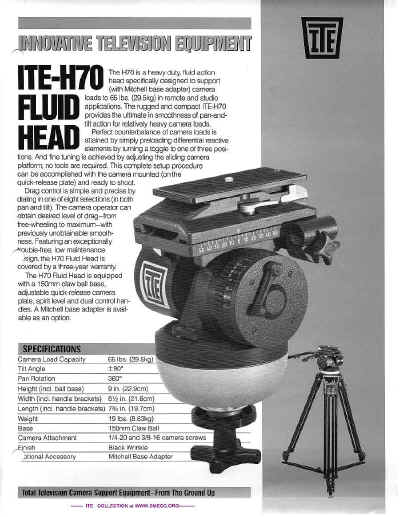 |
|
|
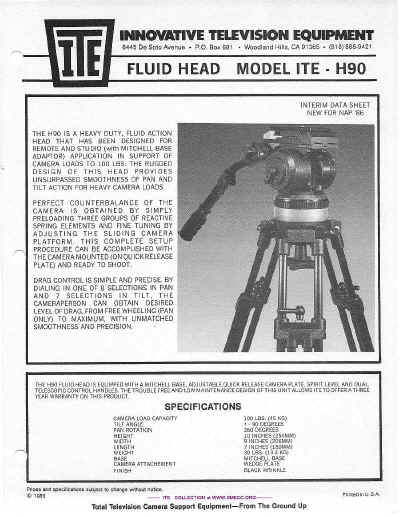 |
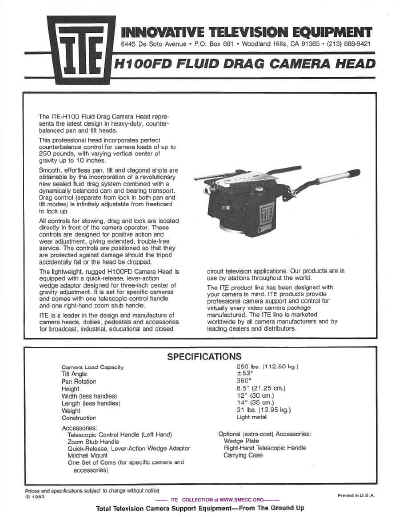
 |
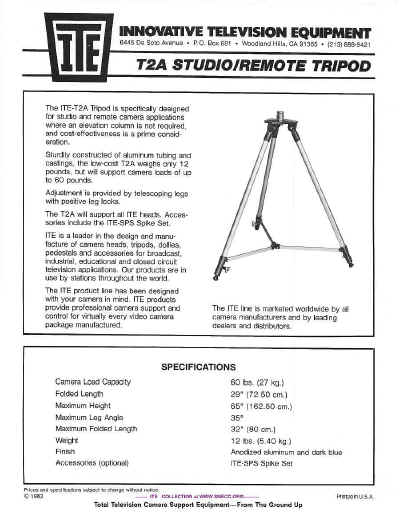
 |
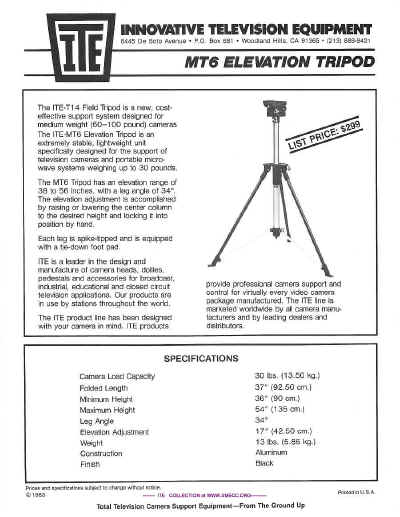
 |
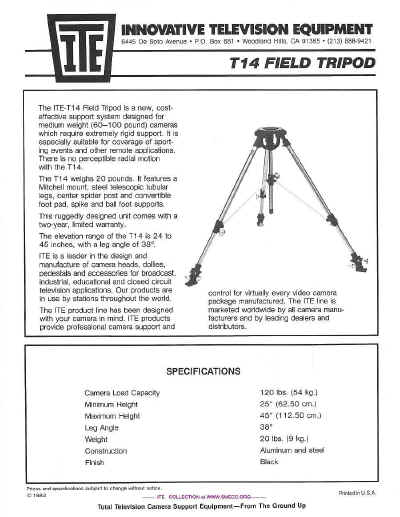 |
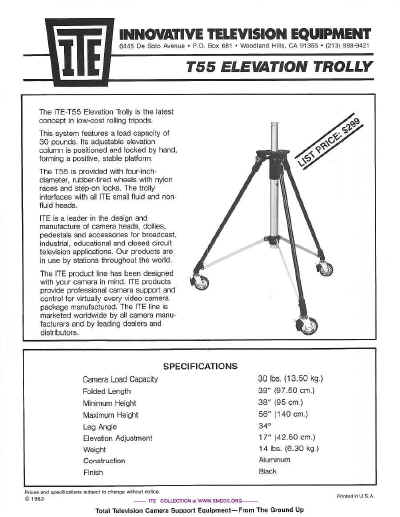
 |
|
|
 ITE
D6 DOLLY Diagram ITE
D6 DOLLY Diagram  |
The ITE-D8 Dolly
The ITE-D8 Dolly is a heavy-duty system
designed for support of camera loads of
up to 250 pounds. It is a perfect
companion to the ITE Model MT1, T10
and new T14 family of tripods.
This Dolly is of rugged design and
includes 8x1 %-inch durathane-tired
wheels which may be indexed at 450
increments and positively locked at any
position.
The wheel system incorporates a 45-inch
pivot diameter with two-inch, heavy-duty
legs which may be locked into 1200 position
with respect to each other or folded
into a compact package for storing.
ITE Tripods are easily attached to the 08
Dolly by use of a spherical ball socket
and over-center retainer lock screw/knob.
Cable guards are available at no additional
cost, if required.
ITE is a leader in the design and
manufacture of camera heads, dollies,
pedestals and accessories for broadcast,
industrial, educational and closed circuit
television applications. Our products are
in use by stations throughout the world.
The ITE product line has been designed
with your camera in mind. ITE products
provide professional camera support and
control for virtually every video camera
package manufactured. The ITE line is
marketed worldwide by all camera manufacturers
and by leading dealers and
distributors.
|
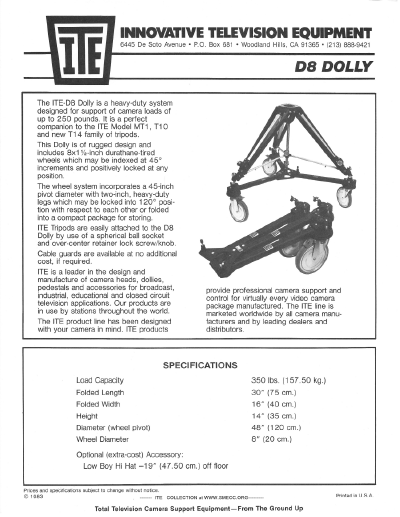
SPECIFICATIONS
Load Capacity 350 Ibs. (157.50 kg.)
Folded Length 30" (75 cm.)
Folded Width 16" (40 cm.)
Height 14" (35 cm.)
Diameter (wheel pivot) 48" (120 cm.)
Wheel Diameter 8" (20 cm.)
Optional (extra-cost) Accessory:
Low Boy Hi Hat -19" (47.50 cm.) off floor
|
|
|
WEDGE ADAPTOR ASSEMBLIES
The ITE Wedge Plate and Adaptor
combination provide for rapid
attachment and removal of camera
from pan/tilt head.
ITE-ADAPTORS
For interface of all ITE products.
ITE-HH HI-HAT
HANDLES
A wide variety of zoom handles
are available for all ITE tripods.
ITE-H9T47CB CLAW BALL ADAPTOR
Interfaces ITE-H9 Head
to -T4, -T7 and -T12 Tripods.
ITE·CB3 CLAW BALL ASSEMBLY
for -T4, -T7 and -T12 Tripods.
QUICK RELEASE ASSEMBLIES
The ITE Quick Release Assembly
provides for rapid attachment and
removal of camera from pan/tilt
head.
|
 |
|